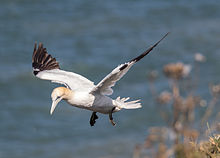Gannet
| Gannet | |
|---|---|

| |
| Northern gannets (Morus bassanus) on Heligoland | |
| Northern gannet calls recorded on Grassholm Island, Wales
| |
| Scientific classification | |
| Domain: | Eukaryota |
| Kingdom: | Animalia |
| Phylum: | Chordata |
| Class: | Aves |
| Order: | Suliformes |
| Family: | Sulidae |
| Genus: | Morus Vieillot, 1816 |
| Type species | |
Linnaeus , 1758
| |
| Species | |
| |
| Synonyms | |
|
Moris | |
Gannets are
.Gannets are large white
Etymology
"Gannet" is derived from
Taxonomy
Morus is derived from Ancient Greek μωρός moros "stupid"[2] or "foolish" due to lack of fear shown by breeding gannets and boobies, allowing them to be easily killed.[3]
Behaviour
Hunting
Gannets hunt fish by diving into the sea from a height of 30 m (100 ft) and pursuing their prey underwater, and have a number of adaptations:
- They have no external nostrils; they are located inside the mouth, instead.
- They have air sacs in the face and chest under the skin, which act like bubble wrap, cushioning the impact with the water.
- The position of their eyes is far enough forward on the face for binocular vision, allowing them to judge distances accurately.[4]
Gannets can achieve speeds of 100 km/h (60 mph) as they strike the water, enabling them to catch fish at a much greater depth than most airborne birds.
The gannet's supposed capacity for eating large quantities of fish has led to "gannet" becoming a description of somebody with a voracious appetite.[citation needed]
Mating and nesting


Gannets are colonial breeders on islands and coasts, normally laying one chalky-blue egg. They lack brood patches and use their webbed feet to warm the eggs.[5] They reach maturity around 5 years of age. First-year birds are completely black, and subsequent subadult plumages show increasing amounts of white.
Northern gannets
The most important nesting ground for
Systematics and evolution

The three gannet
| Common name | Scientific name and subspecies | Range | Size and ecology | IUCN status and estimated population |
|---|---|---|---|---|
| Northern gannet (also known as "solan goose") | Morus bassanus (Lichtenstein, MHC, 1823) |
North Atlantic on coasts influenced by the Gulf Stream
|
Size: Habitat: Diet: |
LC
|
| Cape gannet | Morus capensis , 1882
Milne-Edwards |
Southern Africa in three islands off Namibia and three islands off South Africa
|
Size: Habitat: Diet: |
EN
|
| Australasian gannet | Morus serrator (Gray, GR, 1843) |
Coasts of | Size: Habitat: Diet: |
LC
|
Most fossil gannets are from the Late Miocene or Pliocene, when the diversity of seabirds in general was much higher than today. The cause the decline in species at the end of the Pleistocene is not clear; increased competition due to the spread of marine mammals may have played a role.
The genus Morus is much better documented in the
Fossil species of gannets are:
- Morus loxostylus (Early Miocene of EC USA) – includes M. atlanticus
- Morus olsoni (Middle Miocene of Romania)
- Morus lompocanus (Lompoc Late Miocene of Lompoc, USA)[7]
- Morus magnus (Late Miocene of California)
- Morus peruvianus (Pisco Late Miocene of Peru)
- Morus vagabundus (Temblor Late Miocene of California)[7]
- Morus willetti (Late Miocene of California) – formerly in Sula[7]
- Morus sp. (Temblor Late Miocene of Sharktooth Hill, US: Miller 1961) – possibly M. magnus
- Morus sp. 1 (Late Miocene/Early Pliocene of Lee Creek Mine, US)
- Morus sp. 2 (Late Miocene/Early Pliocene of Lee Creek Mine, US)
- Morus peninsularis (Early Pliocene)
- Morus recentior (Middle Pliocene of California, US)
- Morus reyanus – Del Rey gannet (Late Pleistocene of W US)[7]
Cultural references
In many parts of the United Kingdom, the term "gannet" is used to refer to people who steadily eat vast quantities of food, especially at public functions.[8]
Young gannets were historically used as a food source, a tradition still practised in
In "The Bookshop Sketch", originally from At Last the 1948 Show (1967), a customer (Marty Feldman) asks the bookshop proprietor (John Cleese) for "the expurgated version" of Olsen's Standard Book of British Birds, "the one without the gannet", because he does not like gannets due to their "long nasty beaks". Desperate to satisfy the customer, the proprietor tears the page about the gannet out of the book.[11][12] The sketch is reprised in Monty Python's Contractual Obligation Album, where the customer (Graham Chapman) says he does not like the gannet because "they wet their nests."[13]
In Series 1, Episode 3 of
References
- ^ "gannet". Oxford English Dictionary (Online ed.). Oxford University Press. (Subscription or participating institution membership required.)
- ^ Liddell, Henry George; Scott, Robert (1940). "μωρός". A Greek-English Lexicon. Perseus Digital Library.
- ISBN 978-1-4081-2501-4.
- ^ Wolfaardt, Leight. "Adaptations for Diving and Hunting Fact Sheet" (PDF). Birdlife.org. Retrieved August 7, 2023.
- ^ Tucker, B.W. "Brood-patches and the physiology of incubation" (PDF). British Birds. 37 (2): 22–28.
- ^ Munro, Alistair (18 March 2015). "Scotland's gannet population soars across country". The Scotsman. Retrieved 21 July 2017.
- ^ JSTOR 1365299.
- ^ "Gannet: definition of gannet in Oxford dictionary (British & World English)". 2014-07-06. Archived from the original on July 8, 2012.
- TheGuardian.com. 2014-07-06.
- ^ "BBC News – Gaga for guga: Ten things on Scottish island delicacy". BBC News. 2014-07-06.
- ^ "The Bookshop Sketch", MontyPython.net
- ^ Archived at Ghostarchive and the Wayback Machine: HarvestGod (26 November 2009). "Monty Python – Bookshop Sketch (Monty Python's Contractual Obligation Album)" – via YouTube.
- ISBN 9780486782935.
- ^ Archived at Ghostarchive and the Wayback Machine: "Gordon Ramsay's The F Word Season 1 Episode 3". YouTube.
External links
- Gannet videos on the Internet Bird Collection




